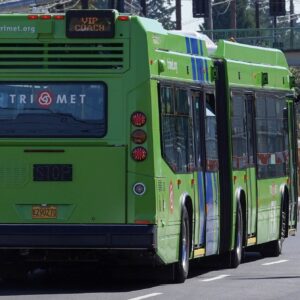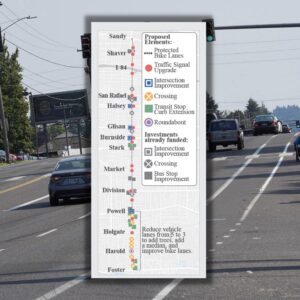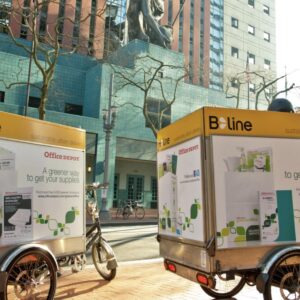
for a transit corridor.
The Federal Transit Administration (FTA) has announced that Metro has won a $2 million grant to do an analysis of the “Southwest Corridor” project. The corridor would run from downtown Portland south via Barbur Blvd (99W) to Sherwood. This could bring major changes to Barbur Blvd and help tame the motor vehicle traffic on that street that has led to two high profile fatalities this year.
Below is a short blurb on the project:
This corridor runs along I-5 and SR 99W between downtown Portland and Sherwood (17 miles). This corridor is a high-priority for transit investment in light of livability needs, support of the regional economy, and potential environmental benefits and other factors. There is affordable housing availability and transit connectivity. Also, there is congestion. The current bus service is well-patronized.
The FTA awarded a total of $25.7 million in this grant cycle.
The $2 million will help Metro pay for an “alternatives analysis,” a key milestone in the FTA’s New Starts program, which is the primary source of federal funding for transit projects.
From the FTA announcement:
“Conducting an “alternatives analysis” ensures that various costs and benefits, route options, and other important considerations are taken into account as part of FTA’s capital planning process… The analysis is complete once a locally preferred alternative is selected and adopted as part of the affected region’s long-range transportation plan.”
This is great news for Southwest Portland neighborhood advocates who have been working for years to bring transportation investment to Barbur Blvd. This study is focused on transit, but if walking and biking advocates are present at the start of the process, the potential plans could include many things that would improve the environment for human-powered transportation.







Thanks for reading.
BikePortland has served this community with independent community journalism since 2005. We rely on subscriptions from readers like you to survive. Your financial support is vital in keeping this valuable resource alive and well.
Please subscribe today to strengthen and expand our work.
Does this mean the lightrail to Tigard will be sooner than we had thought?
strange timing… AROW, FOBB, Angela Burke, SWNA, ODOT… but that is a great news…
Put a station right there
“just north” of the entrance to the Town and Country Apartments (4820 SW Barbur).
Have a railroad crossing gate that blocks Barbur so that pedestrians can cross safely for at least 30 seconds.
Call it the Angela Burke Memorial Station.
It will be memorially and good for urban transportation choice.
The simple existence of a crossing in the middle of this de facto high speed raceway will break up the speed/timing rhythm that allows autos to cruise here at +60MPH.
Any transit station will have to have extra street lighting, something this area sorely lacks.
I really feel like even if they don’t extend LR, Barbur would be an excellent candidate for true bus rapid transit. The hills to one side and I-5 to the other make extensive construction difficult, but BRT could use the space that’s already available. The only problem is selling the BRT brand to a Portland that’s used to thinking in the illusory Bus vs. Rail dichotomy.
Hear hear! Cheaper, friendlier to bicyclists because it doesn’t put down rail in the street. “Selling Portland” would also have to include selling the BTA on the idea, too.
My close calls while commuting by bicycle on Barbur are already posted on the Bike Portland SMaRT Tool. Bike commuting is about getting from A to B, just like car commuting. Barbur is the most efficient way to get to downtown from many SW Portland addresses. On my commute, there are seven sections where I need to take the 99W trafic lane due to narrow bridges, no roadway outside of the fog line, guardrails at the fogline, and the always sketchy Naito-Barbur split. Seeing serious funding and planning to improve cyclist and pedestrian safety on this 45 mph corridor is a welcome relief.
No, this is not serious funding to improve bicycle safety. It’s serious funding for improving transit, provided by the Federal TRANSIT Authority. In Portland, that means putting down more light rail tracks. Since people have to get on and off the train, stations will have to be located at the edge of the street so people won’t have to cross multiple lanes of traffic. That means that the rails will go in the same place that bicyclists want to go.
I’m concerned that bicyclists will simply be an afterthought, and that the situation after installation of a rail line on Barbur will be worse than what we have now.
As ugly and suburban sprawl-ifed as Barbur is an elevated train line would be an improvement.
If only we could get bi-directional bikeways on the side like the Hawthorne Bridge.
Step 1: steal auto subsidies.
Step 2: Dream Big!
LIKE
I just hope they build the MAX line there to serve communities, and not place them in inconvenient, pedestrian-unfriendly places where noone goes. Most of Barbur Blvd is really not that ideal of a transit corridor.
The corridor referenced is around 15 miles long, and serves several municipalities. It is currently congested with private motor vehicles each morning and evening. One road (by several names) and right-of-way goes practically to Newberg. (It does go to Newberg, but the study ends in Sherwood). There are plenty of pedestrians along the way. “Most of Barbur Blvd” is only a fraction of this “corridor”.
Please, take care of yourself this Christmas. A recent joint study conducted by the Department of Health and the Department of Motor Vehicles indicates that 23% of traffic accidents are alcohol related.
This means that the remaining 77% are caused by assholes who just drink coffee, carbonated drinks, juices, milk, water, and shit like that.
Therefore, beware of those who do not drink alcohol. They cause three times as many accidents. This message is sent by someone who cares about your well being.
MAX to Sherwood along the existing 99 corridor is a great idea.
Rapid bus service sounds good but, the reason I prefer MAX is that it is permanent infrastructure. My reasoning is that MAX would cause the removal of traffic lanes for cars hence, making 99/Barbur less convenient for driving. Even though they will gripe mightily about the construction costs and inconvenience, no conservative politician will ever advocate removing a billion dollars of track after it has been built. Watching the train zip past while you sit idling along Barbur will cause folks to make the switch. With bus service, you don’t create the disincentive to drive plus you will see more crashes as impatient drivers take risks and accelerate to highway speeds to pass the bus. Back in the day, I would see all manner of stupid driving as people tried to get past the old articulated express buses that Tri-Met ran before Westside MAX was built.
Just a thought, but how many people do you think see the train zip by while they sit in traffic on 26 waiting to drive through the tunnel? There’s probably a lot of reasons people don’t make the switch if they haven’t already, so I won’t try to speculate. BRT makes sense for a project like this because it doesn’t require spending a lot of money that we simply don’t have. I like MAX too, but right now it’s just a trophy wife we can’t afford and BRT is a functional equivalent that we can.
Yeah, this is transit funding, but it fills in a big piece of the financial puzzle that will get the Southwest Corridor refinement planning process off the ground. And yes, the SW Corridor process is primarily about getting to a preferred alignment/mode alternative for the next MAX line, but it’s going to look at all modes as part of the analysis. 2035 RTP p. 6-8 bullets out elements that this planning process will address, including: “Facilities to improve bicycle and pedestrian safety along Barbur Boulevard and access to
transit services and local destinations.”
A 2 million dollar “study” sounds like a boondoggle to me.
The recent right-turn death at Lombard notwithstanding, the re-construction of old 99W in north Portland, i.e N. Interstate Ave., with light rail, bike lanes, better pedestrian facilities and fewer traffic lanes has been a great success for all modes. Need to do the same with that other leg of old 99W.
re BRT, you have to have exclusive right of way no matter the the vehilce type to offer real high capacity transit; operating costs are higher for BRT than LRT.
I expect to see a tunnel option that serves OHSU and possible HIllsdale then emerges somewhere out past the Fred Meyer store.
I totally agree, part of the line should be underground. Anyways, some of the hills that 99W goes up & down are too steep for MAX trains to negotiate. Underground trains have an added benefit of being faster, as well.
OH BOY! Another light rail line heading south that no one will ride – just like the WES line!!! YIPEE!!!
Quoted from above:
“rigormrtis December 22, 2010 at 9:42 am A 2 million dollar “study” sounds like a boondoggle to me.”
YA THINK?
🙂